 Barbara Liberatore Black’s rise to managing director of JLL’s South Florida office was not an easy one. Currently the only female executive in her office, Black was also one of the first women in commercial real estate in Miami.
Barbara Liberatore Black’s rise to managing director of JLL’s South Florida office was not an easy one. Currently the only female executive in her office, Black was also one of the first women in commercial real estate in Miami.
She got her start doing tenant representation for Julien J. Studley Inc., the precursor to Savills Studley, in 1981. “I was the only female tenant adviser for years,” Black said. Before securing that gig, she’d tried to get her foot in the door elsewhere, to no avail.
“If you were a man today, I would hire you,” an interviewer told her, reasoning that as a woman who was going to get married, she wouldn’t have the time for the job. Instead, he offered Black a secretarial position. She turned it down.
Times have clearly changed, but in the wake of the allegations of sexual harassment and assault by Harvey Weinstein — and the many similar charges against high-profile men that followed, including starchitect Richard Meier — several, if not all, industries are facing profound questions about company culture and fairness.
However, many women in South Florida’s commercial real estate industry are not seeing a major push to close the gender gap. They say the #MeToo movement hasn’t kicked off the kinds of productive conversations it was intended to inspire. Rather, many male colleagues are “now afraid to say hello” to women, Carol Brooks, co-founder of the brokerage Continental Real Estate Companies (CREC), said. “It’s coming more from a place of their own self-preservation. It’s interesting to see how men are reacting; it’s more fear than compassion or anything,” she said.
The Real Deal examined the male and female representation of agents working for South Florida’s top five commercial brokerages (determined by the dollar volume of sales and leases as reported by the South Florida Business Journal) by analyzing broker license data filed with the state as of Feb. 23. Marcus & Millichap had the lowest percentage of female agents in the tri-county region of Miami-Dade, Broward and Palm Beach counties, with 18 percent.
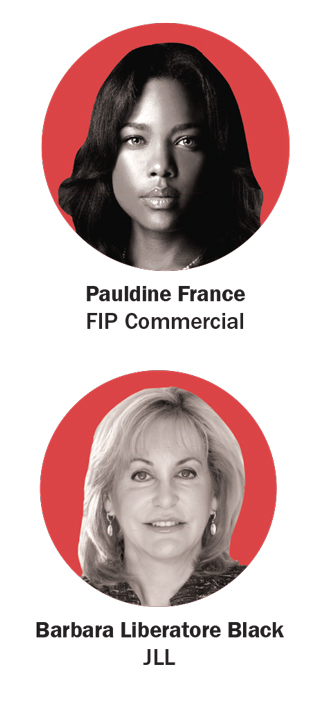 Lori Schneider, senior managing director of investments at Marcus & Millichap, said she thinks the firm has fewer women than the others because the company focuses only on investment sales, which takes time and money “until you establish yourself.” Women typically have less of both than men, she said. Leasing, on the other hand, often provides agents with a crucial base salary.
Lori Schneider, senior managing director of investments at Marcus & Millichap, said she thinks the firm has fewer women than the others because the company focuses only on investment sales, which takes time and money “until you establish yourself.” Women typically have less of both than men, she said. Leasing, on the other hand, often provides agents with a crucial base salary.
CBRE had the highest percentage of women agents, with 39.8 percent, and JLL closely followed with the second highest representation of women, 38.6 percent, according to TRD’s analysis.
Both CBRE and JLL recently won industry awards for their gender inclusion. CBRE, where three of the firm’s board members are women, received the Diversity & Inclusion Award from the Mortgage Bankers Association in February. In March, JLL was named one of the National Association for Female Executives’ “Top Companies for Executive Women.”
CBRE and JLL’s numbers of female brokers in South Florida are better than national averages. The Commercial Real Estate Women (CREW) Network Benchmark study conducted in 2015 — the most recent data set of its kind that’s available — showed that only 23 percent of leasing and sales brokers in the U.S. were women in 2015. But that number was up from 20 percent five years earlier. Between 2010 and 2015, women went from representing 32 percent of the total commercial real estate workforce to 36 percent nationwide. The subsector with the highest concentration of women was property management, with 51 percent of the asset, property and facilities management workforce female, up from 47 percent in 2010.
And while the CREW research found that women made 23.3 percent less than men in the field in 2015, all of the women contacted for this story had a different experience. Female brokers said that because most positions are commission-based, the wage gap isn’t much of an issue. “The good news about that is a woman who is driven can be equal or better [than a man], and she will get paid,” Black said. “I think this is one of the few careers where women get equal pay.”
The achievement gap
Although there’s been progress in overall male-to-female ratios, the gender gap is still quite vast when it comes to women in leadership positions. CREW’s 2015 study found that only 9 percent of the women who were surveyed held executive roles, compared to 17 percent of the men who participated in the study.
The industry is also facing an aspirational gap between men and women. Forty percent of men surveyed by CREW said they wanted C-suite positions compared to only 28 percent of women. And once men had between six and 10 years of experience, they rose through the ranks at a faster pace than women, the report found.
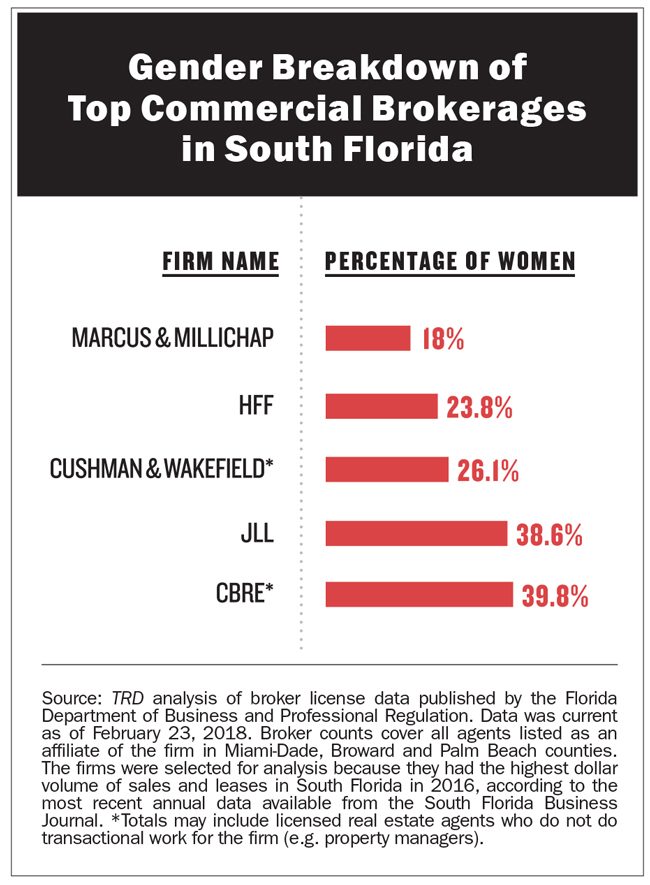
“Men are much more vocal than women. When you don’t speak up and you don’t ask for the job, you don’t get it,” said Sara Hernandez, president of CREW-Miami.
Women developers are also lacking in the industry because the field requires a track record and capital, said Avra Jain, a commercial developer in Miami’s MiMo, Little Haiti, Miami River and Overtown neighborhoods.
“When I first came down to Miami [17 years ago] and I walked into a meeting to buy a piece of property, the broker kept talking to the man next to me,” Jain said.
The perils of after-hour events
“‘Welcome to the company. I Googled you hoping to find some bikini shots online,’” Pauldine France, vice president of strategic investments at FIP Commercial, recalled a man saying on her first day at a new job. “I once had a COO I ran into at a party who was trying to get me drunk to take me home. His wife was at the same party,” she added.
Most women in the industry who were contacted for this story agreed that there’s been some progress in hiring more women, but the presence of some bad actors remains a big issue.
France got her start in 2003 as a brand ambassador for Tony Cho when he launched Metro 1 Properties. She was later a financial adviser at Morgan Stanley, then worked for Shawmut Design and Construction in New York, Thor Equities in Miami and, more recently, spent a year working for RKF, also in Miami.
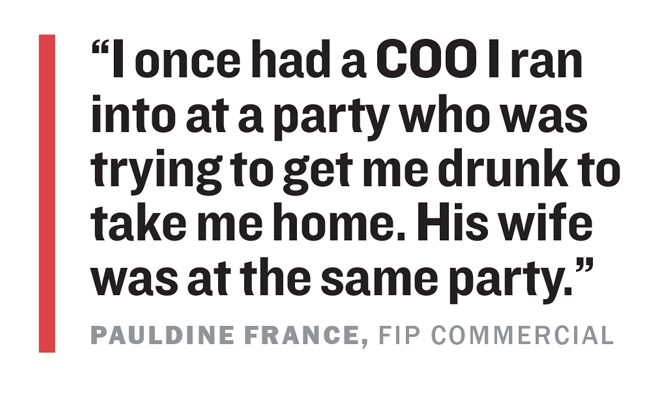
France is, as she describes herself, a “six-foot-tall black chick with green eyes.” She’s faced more than her share of unwanted attention, she told TRD. “I’m used to people looking at me. In commercial real estate, I am a unicorn of a unicorn,” she said. “I’ve had inappropriate, ‘let me take you home’ comments.”
The necessity of after-hours networking doesn’t help things. Going to nightclubs, strip clubs and bars is still a way to get deals done in Miami, sources said. There’s also still a lot of golfing.
“Half of these guys just want to party, and the business facilitates partying” said Mika Mattingly,
executive vice president of Colliers International South Florida.
Some women push themselves to head to the golf course or boozy networking events even when it’s uncomfortable. CBRE’s Carol Ellis-Cutler, first vice president of advisory and tenant services in Miami, attended a conference earlier this year where she was one of a handful of women out of a crowd of 800. She later attended the golfing event, where she was the only woman — alongside 32 men.
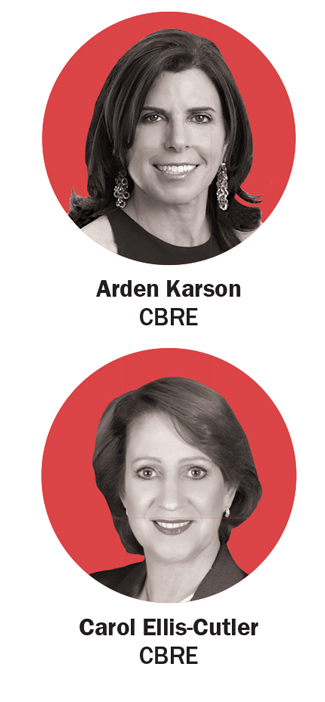 However, Ellis-Cutler and Arden Karson, senior managing director of CBRE South Florida, both said they also use their gender to their advantage. “Being the only woman at the table, they love that,” Karson said, referencing her male colleagues. She squeezed her way into a dinner during a CRE Finance Council event because she wanted to do business with the group.
However, Ellis-Cutler and Arden Karson, senior managing director of CBRE South Florida, both said they also use their gender to their advantage. “Being the only woman at the table, they love that,” Karson said, referencing her male colleagues. She squeezed her way into a dinner during a CRE Finance Council event because she wanted to do business with the group.
“I was the only woman out of 20 people, and they all wanted to sit with me,” Karson said, noting that the extra attention she received was not inappropriate. The men, she said, just wanted to speak to a woman because it was “a refreshing change.”
Men can be more inclined to share information with women, some female brokers said. But that too can have its downside. There’s a fine line between being “approachable and nice” and being “firm,” France said. “You have to deliver this coolness while still keeping that meter stick in front of them,” she said. “Nine out of 10 times, ‘super cool’ can become ‘I can make comments about your new push-up bra.’”
Mentoring the next generation
When considering ways to resolve some of these murky issues, many women said that mentoring a new generation of female brokers is the most important work that needs to be done. And South Florida’s a good place for that: A number of women in leadership roles in commercial real estate own their own companies or work for women who do.
Brooks, of CREC, got her start working in the corporate real estate lending department at Southeast Bank and moved on to the Continental Companies, where she was director of the commercial office leasing department. In the late ‘80s, she considered working at other brokerages and said, “Screw that, I’ll start my own company.”
At that company, a boutique commercial firm she co-founded with Warren Weiser, 51 percent of its 120 employees are female. Two of its six partners are women, and half of its department heads are women. More than 60 percent of CREC’s property managers are women, and 26 percent of the company’s brokers are women. “There are just such high barriers to entry otherwise, so we’ve created our own system,” Brooks said.
Her approach to nurturing female talent development has paid off in the eyes of Sabrina Stimming. Brooks mentored Stimming, who started as an executive assistant and was promoted to marketing assistant, then marketing director. An opening appeared in retail leasing, and now Stimming is director of retail leasing and a partner at CREC. She believes that had she started her career at a traditional brokerage like a CBRE, “it’s probably not likely I would be a head of a department there.”
“If you look around at other firms in our industry, the only women you see in any sort of leadership positions are women who form their own companies,” Stimming added.
Without a mentor, Collier’s Mattingly developed her own strategy for success that many women in the industry adopt: Be the best at the job. She’d pick a neighborhood or area and become an expert on it. “I picked Sunset Harbour, which I liked at the time, and I farmed the fuck out of it,” she said.
From Metro 1, where Mattingly started in 2006 as a commercial associate, she went to Sterling Equity Commercial, where she’d “transact all day off-market, but no one would trust me with big listings.” She eventually represented Moishe Mana in nearly all of his acquisitions in downtown Miami’s Flagler District, which to date has totaled $267 million on 1 million square feet of building space and eight acres of land.
In 2016, Mattingly joined Colliers and is building her team out of an office in downtown Miami. Although it’s not her own company, it’s clear that she’s running her own operation out of the ground-floor retail space on Flagler Street. She said she’s teaching her team to become neighborhood experts, as she did, by learning every property and zoning before they start selling.
Tere Blanca, founder, chairman and CEO of Blanca Commercial Real Estate, also wants to nurture female talent. She left Cushman & Wakefield to start her own firm in 2008 and is responsible for mentoring everyone in the 22-person office, including a few female agents. In her view, the lack of women in the field may stem from them just not knowing about it. “I don’t think a lot of young women understand the opportunities that exist in the industry,” she said.
Ellis-Cutler and some of her colleagues at CREW-Miami introduced themselves to a group of high school girls by telling them, “We don’t sell single-family homes. We can sell the entire multifamily building.”
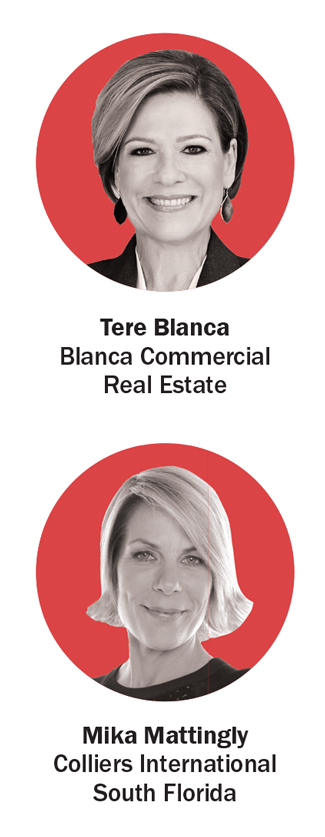 CBRE created its Women’s Network in 2000; it now has 3,500 members nationwide and hosts quarterly events. The gender gap at CBRE and other major commercial brokerage persists, but Karson acknowledged that the firm’s numbers are going up.
CBRE created its Women’s Network in 2000; it now has 3,500 members nationwide and hosts quarterly events. The gender gap at CBRE and other major commercial brokerage persists, but Karson acknowledged that the firm’s numbers are going up.
Forging ahead
While women in commercial real estate today see some struggles and disparities, JLL’s Black said the industry has grown to include more women since she got her start in the early ‘80s. “The one thing I’ve noticed is that women feel more empowered to say to their peers or their managers, ‘Hey, that was an off-color joke’ or ‘I didn’t really like the way you said that about me.’ Women are using their voice now to explain that it’s not right,” she said.
However, Black sees two areas where female representation is lacking: tenant advisory and capital markets, both of which are especially profitable sectors of the business. “That’s predominantly still occupied by men, but in time that will change,” she said.
Jain is also optimistic about closing the gender gap in development.
“We’re starting to see more women take on those roles within their families and more women who want to be developers,” Jain said.
